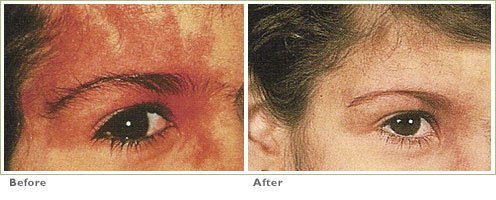Sun Damaged Skin
About V Beam Pulsed Dye Laser
Benefits
Studies have shown that there is clearly a place for both Pulse Dye Laser and intralesional triamcinolone treatments alone and in combination in the management of flat red scars, keloids and elevated (hypertrophic) scars. This is coupled with very good side-effect profile and patient satisfaction levels. Most patients observe considerable improvement in the thickness and redness of their scars, complimented by an improvement itch and discomfort.
Alternatives
Treatment Options: Prescription steroid creams, steroid injections, silicone gel sheet, pressure therapy, surgery, laser therapy, radiation treatment, chemotherapy injections.
How Does it Work?
How Does It Work:
The use of lasers in the management of abnormal scars has evolved greatly in the last twenty years. Several different laser types have been used beginning with the carbon dioxide (CO2), argon and Nd:YAG lasers. These lasers are now very rarely used. CO2 laser was found to have high recurrence rates ranging from 75–95% and in many of the studies involving the use of Nd:YAG laser, the outcomes are not well documented.
Pulse Dye Laser Treatment for Scars and Keloids: Pulse Dye Laser was first used in 1993 for scars and in 1995 for keloids. Results showed improvement in redness, thickness and texture of the scars. A published study in 1993 revealed that 100% of patients involved in the study showed flattening of the elevated scars. This desireable outcome is thought to be due to the effect of the Pulse Dye Laser on cutaneous blood vessels, causing them to break down with resultant reduction of oxygen flow to the scar tissue, leading to the reduction of collagen.
Injection of steroid into the scar tissue works by decreasing the abnormal proliferation of fibroblast cells in the scar tissue, and halting the growth of existing fibroblasts. This leads to a reduction in collagen synthesis and production of inflammatory cytokines, which are two of the factors involved in the formation of the scars. It has been shown to be most effective on young scars but still has a place in the treatment of older ones, especially in eliminating symptoms.
Who is a Candidate?
Anyone with keloid or elevated scars
What Can I expect?
The treatment of keloid and hypertrophic scars is one that has challenged clinicians for generations and continues to do so today. Even with the bank of knowledge that continuing research into the cause of these scars has provided, there is still a lack of treatment options that are infallible. Management must be tailored to each individual in turn and take into account several important factors such as the age of the scar, its size, location and thickness. However, even taking into account these factors, it is impossible to predict an individual’s response to a certain treatment. With so many treatments currently available, it is common for more than one modality to be used in the treatment of one patient’s scars. Pulse Dye Laser
Safety & Side Effects
These procedures are very safe. Possible localized thinning of the surrounding skin and loss of skin pigment is rarely seen. Side effects are rare and generally temporary. The specific risks and the suitability of extractions can be determined only at the time of the consultation.
Recovery Time
None
Does it Hurt?
Minimal discomfort in noted.
Before Treatment Instructions
None
After Treatment Instructions
None
Who Performs the Treatments?
Our Physicians, Physician Assistants and Nurses
V Beam Pulsed Dye Laser Gallery
V Beam Pulsed Dye Laser for Red Birthmarks
*Results may vary.








